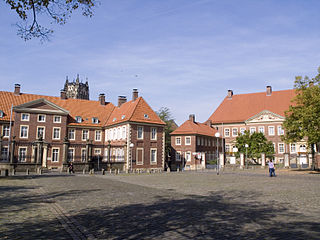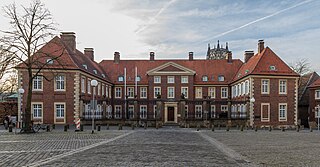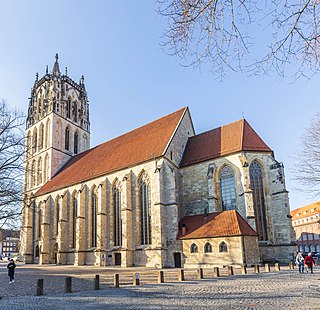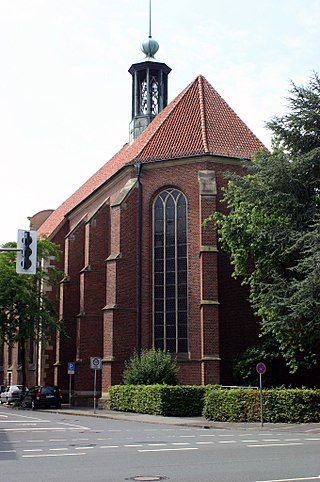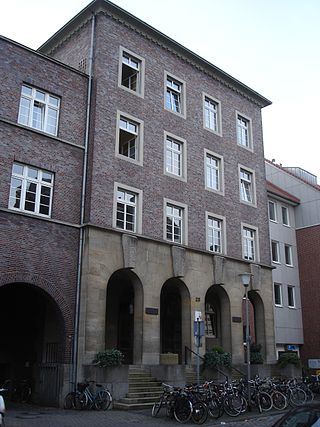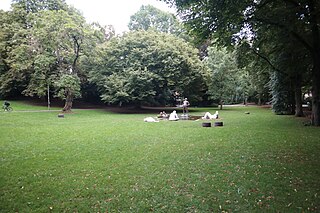Self-guided Sightseeing Tour #1 in Münster, Germany
Legend
Tour Facts
2.9 km
37 m
Experience Münster in Germany in a whole new way with our free self-guided sightseeing tour. This site not only offers you practical information and insider tips, but also a rich variety of activities and sights you shouldn't miss. Whether you love art and culture, want to explore historical sites or simply want to experience the vibrant atmosphere of a lively city - you'll find everything you need for your personal adventure here.
Individual Sights in MünsterSight 1: Martinikirche
St. Martini is one of the oldest Roman Catholic sacred buildings in the Westphalian Minster under the patronage of St. Martin and was built around the 1180s. It is located on the corner of Martinistraße and Neubrückenstraße near the theatre.
Sight 2: Theater Münster
Theater Münster is a municipal theatre in Münster, North Rhine-Westphalia, Germany, for plays and music theatre. When it opened in 1956 it was regarded as the first new theatre building in Germany after World War II. It integrates some ruins of the former theatre and musical school destroyed in the war.
Sight 3: Apostelkirche

The Apostle Church in Münster is the main Protestant church in the city. It is located in the northern part of the historic old town, about halfway between St. Lamberti and the promenade belt. It was built as a monastery church of the Franciscans and is the first Gothic church building in Münster. From 1517 the Apostle Church was the monastery church of the Minorite monastery.
Sight 4: Kettelersche Kurie
The Ketteler Curia on the Cathedral Square in Münster was built between 1712 and 1716 by the master builder Lambert Friedrich Corfey. The builder was Vicar General Nikolaus Hermann von Ketteler zu Harkotten, who decided in 1711 to build a curia on his property. The building still belongs to the Episcopal General Vicariate and is used as a residential building and archive. In the immediate vicinity of the Episcopal Palace, it forms a magnificent ensemble in the cathedral courtyard.
Sight 5: Bischöfliches Palais
The episcopal palace or the episcopal courtyard at Domplatz 27 in Münster is the residence of the Bishop of Münster and the seat of the episcopal general vicariate.
Sight 6: Archäologisches Museum

The Archaeological Museum of the University of Münster in the "Fürstenberghaus" on the Cathedral Square in Münster primarily serves the Institute of Classical Archaeology and Early Christian Archaeology of the University for teaching and research purposes. In addition, it offers the public an insight into the subject area of archaeology and shows working methods and research findings. The focus of the exhibition is on exhibits from Greek antiquity.
Sight 7: Geomuseum
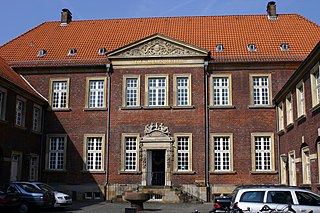
Since its opening in 1824, the Geomuseum of the University of Münster in Münster, Westphalia, which was called the Geological and Paleontological Museum until 2007, has been home to numerous fossils from a wide variety of geological eras in its exhibition. Since it was the only museum in Westphalia with a noteworthy collection of fossils for more than 150 years, many extraordinary finds came to Münster, which are exhibited in the museum and stored in the archive. In many cases, the sites are no longer accessible or exploited, so that some exhibits have considerable scientific value.
Wikipedia: Geologisch-Paläontologisches Museum Münster (DE), Website
Sight 8: St. Petri
St. Petri, also Petrikirche, is a Catholic church in Münster, Germany. As the church of the former Jesuit College, St. Peter's Church is the nucleus of the University of Münster. It is located not far from the cathedral in the university grounds between the Fürstenberghaus, the Faculty of Law and the Faculty of Catholic Theology on the Aa and today serves as the church of the Catholic Student and University Community of Münster (KSHG) and as the school church of the Paulinum Grammar School. Because of the good acoustics, the church is considered a preferred space for sacred concerts; in addition, St. Peter's Church is very much appreciated as a wedding church.
Sight 9: Überwasserkirche
Überwasserkirche is the common name of a Gothic hall church in Münster, North Rhine-Westphalia, Germany. It is a Liebfrauenkirche, dedicated to St. Mary. Officially St. Marien Überwasser, it is also called Liebfrauen-Überwasser. The name literally means "church beyond the water" and describes the location as on the other side of the Aa river, looking from the Münster Cathedral. It was inaugurated as part of an educational Stift in 1040, which later became the University of Münster.
Sight 10: Evangelische Universitätskirche
The Observantenkirche is a church building in the old town of Münster on the corner of Schlaunstraße, Rosenstraße. Until the abolition of the monastery in 1811, it was the monastery church of the Franciscan Observants. The Observant Church is the property of the state of North Rhine-Westphalia and is today the Protestant University Church and Concert Church of the Protestant Theological Faculty of the University of Münster.
Sight 11: Johanneskapelle
The St. Johannes Chapel in Münster is a small Gothic church building on the Breul in the northwest of the historic old town. It belongs to the Protestant Apostle Church congregation and is used by various groups and denominations for divine services in a special form.
Sight 12: Deutsches Studentenheim
The German Student Dormitory (DSH), also known as Breul and formerly Burse, is one of the oldest student dormitories in the Westphalian university city of Münster, Breul 23. It was built in 1928 according to plans by Hans Ostermann, and since March 17, 1986, the façade of the building has been a listed building.
Sight 13: Kreuzschanze
The Kreuzschanze is a green area and former ski jump on the northern edge of the city center of Münster in Westphalia on the promenade at the level of the former Kreuztor. It was built together with the redoubts at the Hörstertor and Servatiitor between 1648 and 1660 and is the only one that has been preserved in its full dimensions. Originally, it was additionally protected by a moat, which is still preserved in the form of two small ponds. Directly southeast of the redoubt is the Buddenturm as the last surviving tower of the former city fortifications. A little west of the Kreuzschanze on Kleimannstraße stands a batardeau.
Share
How likely are you to recommend us?
Disclaimer Please be aware of your surroundings and do not enter private property. We are not liable for any damages that occur during the tours.
GPX-Download For navigation apps and GPS devices you can download the tour as a GPX file.


